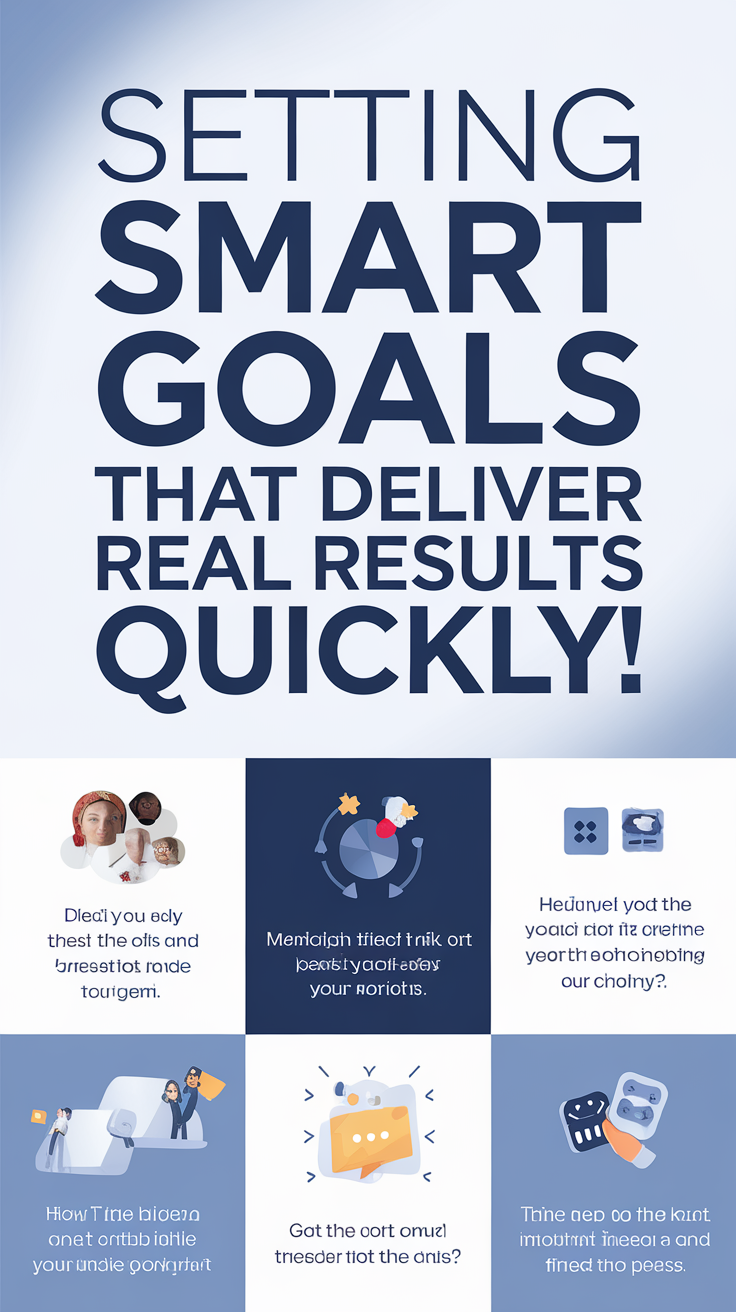Setting SMART Goals That Deliver Real Results Quickly!
To set SMART goals that deliver real results quickly, start by ensuring each goal is Specific, Measurable, Achievable, Relevant, and Time-bound. Clearly define your goal by answering the ‘who,’ ‘what,’ ‘when,’ ‘where,’ and ‘why.’ Break larger goals into manageable tasks and set realistic deadlines to create urgency. Establish measurable benchmarks to track your progress and celebrate small victories to stay motivated. Remember, these structured goals can greatly enhance your success rate. With SMART criteria in place, you’ll find an effective pathway to results. There’s more valuable insights to uncover that can help refine your goal-setting process.
Key Takeaways
- Define specific outcomes by identifying your target audience and desired results to provide clarity and focus.
- Set measurable benchmarks to track progress and evaluate performance, allowing for timely adjustments.
- Ensure goals are achievable by assessing current resources and breaking larger objectives into manageable tasks.
- Create urgency with time-bound deadlines, establishing both short-term and long-term milestones for accountability.
- Celebrate small wins throughout the process to maintain motivation and reinforce positive behavior towards goal achievement.
Understanding SMART Criteria
When you set goals, it’s essential to guarantee they’re not just vague aspirations but rather clear and actionable objectives. Understanding the SMART criteria is fundamental to achieving goal clarity. Each component—Specific, Measurable, Achievable, Relevant, and Time-bound—plays a significant role in shaping your objectives.
The importance of these criteria can’t be overstated. Specificity eliminates ambiguity, giving you a clear target to aim for. Measurable outcomes allow you to track progress, making sure you’re moving in the right direction. Achievable goals maintain motivation, preventing discouragement from unattainable expectations.
Relevance confirms your objectives align with your broader aspirations, fostering commitment. Finally, a Time-bound element instills urgency, pushing you to take action rather than procrastinate.
When you incorporate these criteria into your goal-setting process, you create a framework that enhances focus and accountability. It’s not just about having goals; it’s about having the right goals.
Crafting Specific Goals
How can you guarantee your goals are truly specific? To achieve goal clarity, you need to define what success looks like for you and your target audience. Start by answering the ‘who’, ‘what’, ‘when’, ‘where’, and ‘why’ of your goals. This level of detail transforms vague intentions into actionable objectives.
Here’s a simple framework to help you craft specific goals:
| Goal Component | Description | Example |
|---|---|---|
| Who | Identify your target audience | Customers aged 25-35 |
| What | Define the outcome you desire | Increase website traffic |
| When | Set a clear timeframe | By the end of Q2 |
Utilizing this table, you can ascertain that each goal is not just a statement but a well-defined target. By doing so, you’ll enhance your ability to focus on what’s important, making it easier to track your progress. Remember, specificity breeds accountability, and accountability drives results. Aim for precise goals that resonate with your target audience to maximize impact.
Measuring Progress Effectively
Effective progress measurement is essential for maintaining momentum toward your goals.
It’s vital to implement robust tracking metrics that provide clarity on where you stand. Regularly evaluating your progress not only highlights achievements but also identifies areas needing improvement.
To measure progress effectively, consider these strategies:
-
Set clear benchmarks****: Define what success looks like at various stages.
-
Utilize tracking metrics: Employ quantitative measures to evaluate your performance.
-
Establish feedback loops****: Create systems that allow for continuous feedback, helping you adapt quickly.
-
Review regularly: Schedule consistent check-ins to evaluate your progress and adjust your strategies.
-
Celebrate small wins: Acknowledge incremental achievements to keep motivation high.
Ensuring Achievability
Setting goals that are achievable is essential to your overall success. To guarantee this, you need to establish realistic expectations based on your current circumstances and capabilities.
Start by evaluating your resources—time, skills, and support systems. This resource evaluation will help you gauge what’s truly possible, allowing you to align your ambitions with what you can realistically accomplish.
When setting your goals, consider breaking them down into smaller, manageable tasks. This approach not only makes the goals less intimidating but also helps you identify potential obstacles early on.
Setting Time-bound Deadlines
Deadlines can be your best friend when it comes to achieving goals. They create a sense of urgency, pushing you to prioritize effectively and manage your time wisely.
Understanding deadline importance is vital for honing your time management skills, which ultimately leads to greater productivity and success.
To set effective time-bound deadlines, consider these strategies:
- Be Specific: Clearly define what you want to achieve by the deadline.
- Break It Down: Divide larger goals into smaller, manageable tasks with their own deadlines.
- Stay Realistic: Confirm your deadlines are achievable to avoid frustration and burnout.
- Monitor Progress: Regularly check in on your progress, adjusting deadlines when necessary.
- Reward Yourself: Celebrate when you meet your deadlines to reinforce positive behavior.
Frequently Asked Questions
How Do I Prioritize Multiple SMART Goals Simultaneously?
How do you juggle multiple goals without dropping any? Utilize goal prioritization techniques like the Eisenhower Matrix and time-blocking for effective simultaneous goal management, ensuring each goal receives the attention it deserves while maximizing your productivity.
Can SMART Goals Be Adjusted After Setting Them?
Absolutely, you can adjust your SMART goals. Goal revision is essential for flexible planning, allowing you to adapt to changing circumstances and maintain focus on achieving meaningful results. Embrace the process; it fosters growth and development.
What if My Goals Conflict With Team Objectives?
If your goals conflict with team objectives, prioritize goal alignment through open team communication. Discuss your goals collaboratively, ensuring everyone’s on the same page, and adjust as needed to enhance overall team performance and cohesion.
How Do I Stay Motivated to Achieve My SMART Goals?
How can you stay motivated to achieve your goals? Consider goal visualization to picture success, and enlist accountability partners to keep you on track. Together, they’ll boost your commitment and drive toward your desired outcomes.
What Tools Can Help Track My SMART Goal Progress?
To effectively track your SMART goals, consider using goal tracking apps or spreadsheets. These tools enhance progress monitoring, allowing you to visualize milestones and adjust strategies, ultimately fostering accountability and driving consistent improvement toward your objectives.





